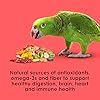When it comes to African Grey parrots, understanding their molting process is essential for any pet owner. This fascinating stage in their development can be intriguing to observe, but it’s also crucial to know how to care for your parrot during this time.
In this article, we’ll delve into the world of African Grey molting, looking at the process, the signs to watch for, and how to help your feathery friend through this natural cycle. So, without further ado, let’s get started and explore the normal molting process for an African Grey parrot.
Understanding the Molting Process
Molting is a natural occurrence in the life of African Grey parrots, as it is for all birds. During this time, your parrot will shed its old, damaged feathers and grow new ones in their place. This process is vital for maintaining the health and beauty of their plumage.
Table of Contents
The Molting Timeline
When Does It Begin?
The molting process for African Grey parrots typically begins when they are around 9 to 12 months old. However, the exact age may vary depending on the individual bird and its living conditions.
Frequency of Molting
African Grey parrots molt once or twice a year, usually during the spring and fall seasons. The frequency of molting can be influenced by factors such as diet, stress, and environmental conditions.
Recognizing the Signs of Molting
Physical Indicators
During the molting process, you might notice a few physical changes in your African Grey parrot. These can include:
- Loose feathers: You may find loose feathers in the cage or see your parrot preening more frequently to remove them.
- New feather growth: Keep an eye out for new feathers, called “pin feathers,” which are encased in a protective sheath. These will eventually open up, revealing the new feather underneath.
Behavioral Changes
Your parrot might exhibit some behavioral changes during the molting process, such as:
- Increased preening: Preening helps remove old feathers and keep new ones in good condition.
- Irritability: Molting can be uncomfortable for your parrot, causing them to be more irritable than usual.
- Decreased appetite: Your parrot might eat less during this time, as their energy is focused on growing new feathers.
Caring for Your African Grey During Molting
Nutrition
Providing a balanced diet rich in vitamins and minerals is essential during the molting process. Make sure your parrot’s diet includes a variety of fruits, vegetables, and high-quality pellets.
Matiniy 2 Pcs Pirate Parrot on Shoulder Life Sized Artificial Parrot Toy for Costume Dress-up Accessory for Halloween Party(Multicolor)
$14.99 (as of 21/12/2025 07:48 GMT +03:00 - More infoProduct prices and availability are accurate as of the date/time indicated and are subject to change. Any price and availability information displayed on [relevant Amazon Site(s), as applicable] at the time of purchase will apply to the purchase of this product.)Bird Toys, Parrot Toys for Large Birds,Natural Corn cob and Loofah Slices Bird chew Toys for African Grey Parrots, Macaws, Cockatoos, Amazon Parrot and other Small and Medium-Sized Parrot (Colorful)
$12.97 ($12.97 / count) (as of 21/12/2025 11:07 GMT +03:00 - More infoProduct prices and availability are accurate as of the date/time indicated and are subject to change. Any price and availability information displayed on [relevant Amazon Site(s), as applicable] at the time of purchase will apply to the purchase of this product.)Kaytee Fiesta Parrot Food, Nutritious and Fun Blend, Supports Skin, Feather, Digestion, Brain and Heart Health, 4.5 pounds
16% OffGrooming
Regularly mist your parrot with water to help remove dust and debris from its feathers. This can also help to soothe their skin and promote healthy feather growth.
Environmental Factors
Maintain a consistent temperature and humidity level in your parrot’s living space to ensure a comfortable environment during the molting process.
When to Seek Professional Help?
While molting is a natural process, it’s essential to monitor your parrot closely for any signs of abnormal feather loss or growth. If you notice any of the following, consult with a veterinarian:
- Bald patches: This could indicate an underlying health issue or stress-related feather plucking.
- Broken or damaged feathers: Examine the new feathers for any signs of deformity or damage.
Conclusion
The molting process is a natural and necessary part of an African Grey parrot’s life. By understanding the signs and providing proper care during this time, you can ensure your feathery friend remains happy and healthy. Don’t forget to consult with a veterinarian if you notice any unusual changes in your parrot’s feather condition or behavior during molting.
FAQ
1. How long does the molting process last for African Grey parrots?
The molting process can last anywhere from 6 to 12 weeks, depending on the individual bird and environmental factors. It’s important to be patient and provide the necessary care during this time.
2. Can I help my African Grey parrot with the molting process?
While you can’t speed up the molting process, you can support your parrot by providing a balanced diet, maintaining a comfortable environment, and offering regular grooming. These actions will help keep your bird comfortable and ensure healthy feather growth.
3. How can I tell if my African Grey parrot is stressed during the molting process?
Signs of stress during molting may include excessive feather plucking, bald patches, or unusual behavior such as aggression or lethargy. If you notice any of these signs, consult a veterinarian for guidance.
4. Is it normal for my African Grey parrot to lose a lot of feathers during molting?
Yes, it is normal for your African Grey parrot to shed a significant number of feathers during the molting process. This is a natural part of the process as old feathers are replaced with new ones. However, if you notice excessive feather loss or bald patches, it’s essential to consult a veterinarian.
5. Do African Grey parrots experience any pain during the molting process?
Molting can be uncomfortable for African Grey parrots due to the growth of new pin feathers. Regular misting and gentle preening can help alleviate some of this discomfort.
























